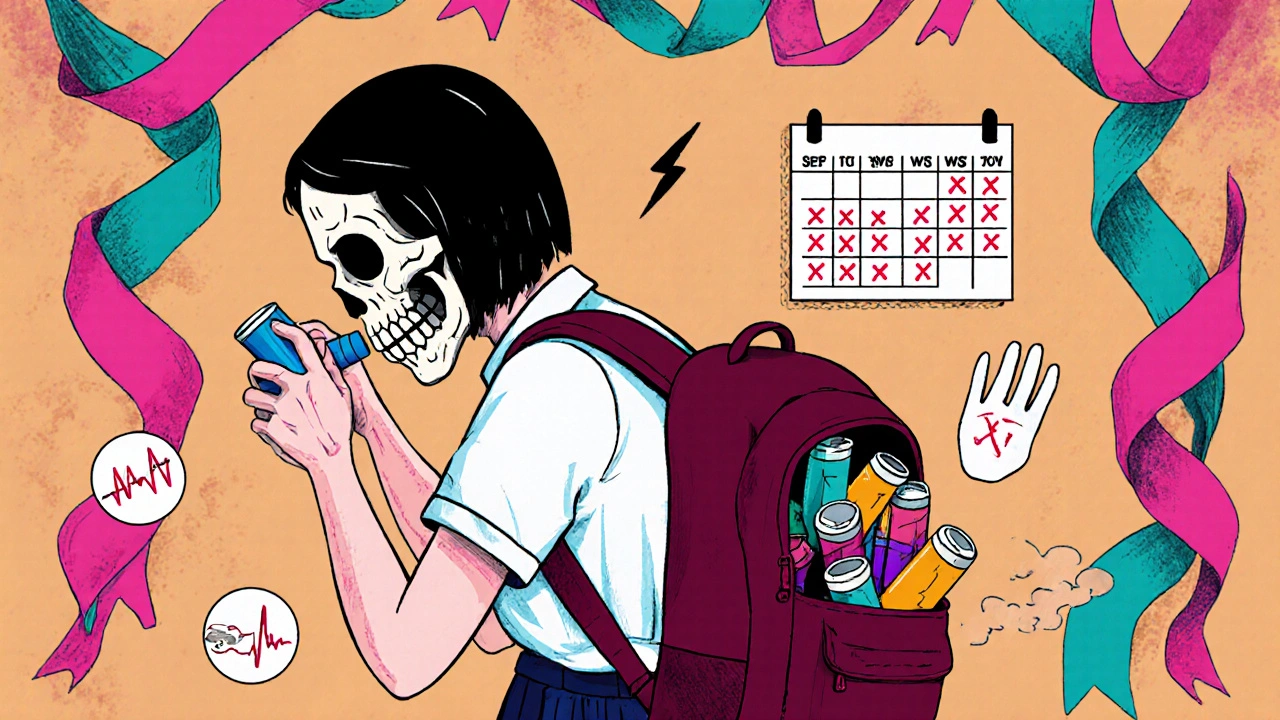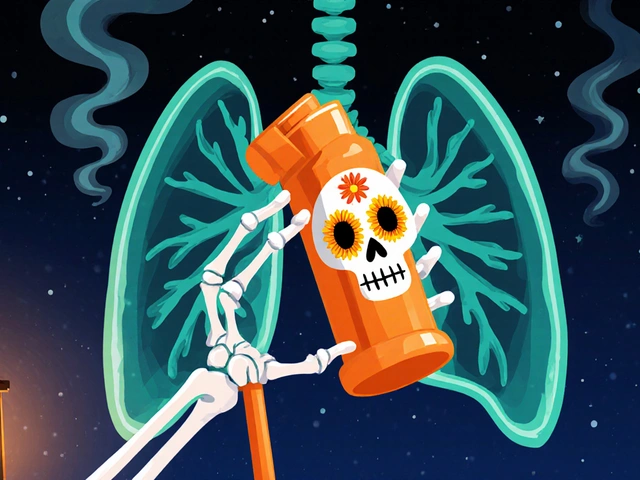Understanding Salbutamol Abuse: How to Spot the Warning Signs

Salbutamol Usage Checker
Assess Your Salbutamol Usage
This tool helps you determine if your salbutamol usage patterns exceed recommended limits and may indicate abuse.
When a trusted rescue inhaler starts feeling like a crutch, it’s time to pause and ask: could this be more than a genuine asthma flare? Salbutamol abuse is a growing concern that slips under the radar because the drug is meant to help, not harm. This guide walks you through what salbutamol is, why it can be misused, and the tell‑tale signs that someone might be leaning on it too heavily.
What is Salbutamol?
Salbutamol is a short‑acting beta‑2 agonist bronchodilator commonly prescribed for asthma and chronic obstructive pulmonary disease (COPD). It works by relaxing the smooth muscles around the airways, opening them up within minutes so you can breathe easier. In most countries it’s sold under brand names like Ventolin, Albuterol, or ProAir, and it’s delivered via metered‑dose inhalers, nebulisers, or oral tablets.
Why Might Someone Abuse Salbutamol?
Salbutamol is designed for short‑term relief, but a few factors tempt misuse:
- Performance pressure: Athletes sometimes use high‑dose inhalers to boost airflow, thinking it gives a competitive edge.
- Psychological dependence: The rapid relief can feel rewarding, especially for people with anxiety who associate breathlessness with panic.
- Ease of access: In many regions it’s available over the counter, making it easy to obtain without a prescription.
- Tolerance buildup: Repeated high‑frequency use can lead the body to need larger doses for the same effect.
When a user begins to rely on salbutamol beyond occasional rescue, the line between therapeutic use and abuse blurs.
Recognizing the Signs of Salbutamol Abuse
Spotting misuse early can prevent serious health consequences. Keep an eye out for these patterns:
- Using the inhaler more than 2-3 times per day, or every few hours, without a clear asthma trigger.
- Increasing the dose without consulting a doctor - for example, moving from a 100 µg puff to a 200 µg puff routinely.
- Demanding refills before the previous prescription runs out.
- Experiencing side effects like trembling, rapid heartbeat, or headache that are ignored or dismissed.
- Relying on the inhaler to manage stress or panic attacks rather than using prescribed anxiolytics.
- Using the medication in non‑medical settings, such as before a workout or exam.
- Hiding inhalers or lying about the number of devices owned.
If you notice several of these behaviors in yourself or someone close, it’s a red flag that the inhaler is being used as a coping tool rather than a rescue aid.

Health Risks of Misusing Salbutamol
Abuse isn’t just a habit; it carries real physiological danger:
- Cardiovascular strain: Excessive beta‑2 stimulation can cause tachycardia, palpitations, and even arrhythmias.
- Reduced drug effectiveness: Overuse can lead to down‑regulation of beta‑2 receptors, making future legitimate doses less effective.
- Electrolyte imbalance: High doses may lower potassium levels, prompting muscle weakness or cramps.
- Paradoxical bronchospasm: In rare cases, the airway may tighten instead of relax, worsening breathing problems.
- Mental health impact: Dependence on rapid relief can fuel anxiety cycles, creating a feedback loop of over‑use.
These complications are why clinicians stress that salbutamol is a “rescue” not a “maintenance” medication.
How to Prevent and Get Help
Prevention starts with education and a solid asthma action plan:
- Set clear usage limits: Most guidelines advise no more than two puffs every four hours and no more than eight puffs in 24 hours.
- Track inhaler counts: Use a diary or a smart inhaler app to log each dose.
- Regular check‑ups: Bring your inhaler to every appointment; doctors can spot patterns you might miss.
- Consider alternative therapies: Long‑acting bronchodilators or inhaled corticosteroids may reduce the need for frequent rescues.
- Seek counseling: If anxiety drives the overuse, cognitive‑behavioral therapy (CBT) or mindfulness can replace the inhaler habit.
- Leverage prescription drug monitoring programs (PDMPs): In Australia, the Therapeutic Goods Administration (TGA) tracks dispensing data, helping clinicians flag early signs of misuse.
When abuse is suspected, a gradual taper under medical supervision is safest. Never stop abruptly, as abrupt withdrawal can trigger severe bronchospasm.

Dosage Patterns: Normal Use vs. Abuse
| Aspect | Typical Therapeutic Use | Indicative Abuse |
|---|---|---|
| Frequency | 1-2 puffs per asthma episode, ≤8 puffs/24 h | ≥3-4 puffs per hour, >12 puffs/24 h |
| Trigger | Sudden wheeze, shortness of breath, exercise‑induced | Stress, anxiety, performance pressure, no clear trigger |
| Side‑effects | Mild tremor, transient palpitations (rare) | Persistent tachycardia, headache, insomnia, hypokalemia |
| Prescription refill pattern | Every 1-3 months as prescribed | Early refill requests, multiple pharmacies |
| Patient behavior | Reports usage, follows asthma action plan | Hides inhalers, lies about dosage |
Quick Takeaways
- Salbutamol is a fast‑acting bronchodilator meant for occasional rescue.
- Frequent, high‑dose use can signal abuse and lead to cardiac, electrolyte, and respiratory complications.
- Watch for patterns like >8 puffs per day, use without an asthma trigger, and early refill requests.
- Prevent misuse with a clear action plan, smart‑inhaler tracking, and professional support for anxiety or performance pressure.
- If abuse is suspected, seek a supervised taper and explore long‑acting alternatives.
Frequently Asked Questions
Can occasional over‑use of Salbutamol cause long‑term damage?
Occasional spikes-say, a few extra puffs during a severe asthma attack-are generally safe. Problems arise when high‑frequency use becomes the norm, leading to receptor tolerance and cardiovascular stress.
Is Salbutamol a controlled substance?
In most countries, including Australia, salbutamol is not listed as a Schedule 8 drug, but its dispensing is monitored because of abuse potential. Some regions restrict over‑the‑counter sales to prevent misuse.
What are the warning signs that a teenager might be misusing an inhaler?
Teenagers may hide inhalers in backpacks, request refills before the previous pack is finished, or use the inhaler before sports events to “boost” performance. They might also experience unexplained jitteriness or mood swings.
Can I use a nebuliser instead of an inhaler to avoid abuse?
Switching devices doesn’t eliminate the risk. The drug’s pharmacology stays the same, so over‑use can still happen. However, nebulisers often require larger doses, which may make misuse more noticeable to clinicians.
How does a doctor taper someone off a high dose of Salbutamol?
A typical taper reduces the daily dose by 10‑20 % each week while introducing a long‑acting bronchodilator or inhaled corticosteroid to maintain control. Monitoring lung function and heart rate is crucial during the process.







Oh, bravo, another self‑diagnosed asthma guru thinks they’ve cracked the code on salbutamol abuse while sipping artisanal coffee. The sublime art of over‑the‑counter heroics is truly a marvel of modern irresponsibility. One puff here, a dram of inhaler there – because why bother with a proper plan when you can just wing it?
Hey folks we all learn together lets share tips on setting simple limits for inhaler use and remember to check in with a doc regularly it helps keep us safe and breathing easy
When we talk about salbutamol misuse we must first acknowledge the broader sociocultural pressures that drive individuals toward pharmacological shortcuts.
In many high‑stress environments, be it academic, athletic, or occupational, the promise of an immediate bronchodilatory effect becomes a seductive allure.
Patients often rationalize that a few extra puffs are harmless, yet the cumulative effect on beta‑2 receptor down‑regulation can be profound.
Clinicians should therefore incorporate detailed usage logs into routine asthma reviews, not merely rely on patient self‑report.
Moreover, the psychological component-where anxiety masquerades as dyspnea-creates a feedback loop that reinforces inhaler dependence.
It is essential to differentiate genuine bronchospasm from panic‑induced hyperventilation, perhaps using peak flow measurements in real‑time.
Education about the distinction between rescue and maintenance therapy should be delivered in plain language, supplemented with visual aids.
Family members, especially caregivers of adolescents, need to be vigilant for hidden inhalers and unexplained refill requests.
Pharmacists also play a crucial role by flagging abnormal dispensing patterns across pharmacy networks.
In regions where over‑the‑counter sales are permitted, regulatory bodies might consider implementing mandatory counseling at the point of sale.
Research indicates that smart inhaler technology can reduce overuse by up to 30 %, highlighting the value of digital adherence tools.
Nevertheless, technology cannot replace the therapeutic alliance formed during face‑to‑face consultations.
The tapering process, when indicated, must be individualized, gradually reducing the dose while introducing a long‑acting bronchodilator or inhaled corticosteroid.
Monitoring for rebound bronchospasm during tapering is paramount, as abrupt cessation may precipitate severe attacks.
Finally, interdisciplinary collaboration-pulmonologists, primary care physicians, mental health professionals-ensures a holistic approach to the patient’s respiratory and psychological health.
Only through such comprehensive strategies can we hope to curb the silent epidemic of salbutamol abuse.
In the quiet corridors of our breath, the inhaler becomes more than a tool; it transforms into a symbol of hidden desperation, a whisper of control amidst chaos. Yet we must not dramatize every puff as a tragedy, for the truth lies in measured vigilance.
Yo, you guys dont realize the gov is using salbutamol as a mind control vector. They push the inhalers in every pharmacy so they can track our breath patterns and feed it into the big data matrix. If you keep overusing, you just give them more data to manipulate you. Stay woke watch the inhaler, dont let them in.
Just a gentle reminder that if you notice someone using their inhaler more often than the prescribed schedule, a kind conversation can be helpful. Simple language and a calm tone go a long way.
Allow me to enlighten you: the pharmacokinetics of salbutamol are well‑studied, and any claim that occasional over‑use is harmless is simply naive. If you truly understand receptor dynamics, you’ll realize that tolerance builds faster than most patients admit. Ignoring this data is not just careless-it borders on negligent.
We have a moral duty to protect vulnerable individuals from slipping into dependence on a medication meant for rescue. When we turn a blind eye to frequent inhaler use, we implicitly condone self‑harm. Let us speak up, set clear boundaries, and champion responsible prescribing.
Hey team! Let’s keep the momentum going-track those puffs, celebrate every day you stay under the limit, and remember there’s strength in asking for help when the pressure builds. You’ve got this!
Incorporating structured inhaler monitoring into your asthma action plan can dramatically improve outcomes; consider leveraging digital adherence platforms that provide real‑time feedback and empower patients to self‑manage effectively.
I hear your concerns and appreciate the supportive tone, it’s important to feel heard when navigating inhaler use.
Of course the American market is the only one that truly respects the power of a good inhaler-anyone else just doesn’t get it, lol. That’s why we gotta keep it in the family, not let those foreign meds mess our heads.
The dialectic of dependence and autonomy in respiratory therapy invites a deeper ontological inquiry: are we merely managing symptoms, or are we confronting the very essence of human fragility? This question, while abstract, informs compassionate clinical practice.
Totally feel you, stay strong! 😊
Interesting thread, glad to see diverse perspectives coming together.